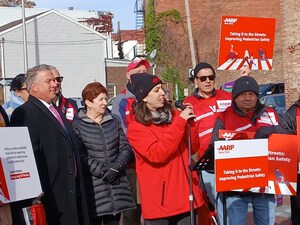AARP Reports Find Brand Name Rx Prices Soar as Older New Yorkers Struggle to Pay for the Basics
New Yorkers 65+ Already Worried About Paying Housing, Utility & Property Taxes as Their Rx Prices Jump 13%
NEW YORK, Nov. 20, 2014 /PRNewswire-USNewswire/ -- Just being able to afford their housing costs has more than half of older New Yorkers worried, but today a new AARP report delivered more bad news: their prescription drug prices are soaring at an alarming rate. According to an AARP Public Policy Institute (PPI) report, retail prices for brand name prescription drugs widely used by older New Yorkers shot up by an average of nearly 13% in 2013, more than eight times faster than the 1.5% general inflation rate and the highest average annual increase since AARP began tracking prescription drug prices in 2004.
The news of higher Rx costs comes on the heels of an AARP report finding older New Yorkers already stretched, strained and stressed by paying for the basics, like housing, utility bills and property taxes.
- Housing: 47% of New Yorkers 65 and older say they worry about paying their monthly mortgage or rent in the coming years, with 30% extremely or very worried.
- Utility bills: 62% report concern about paying their utility bills, which are some of the highest in the nation (46% extremely or very worried).
- Property taxes: 72% worry about their ability to pay their property taxes (48% extremely or very worried).
"When you take a fixed income, combine that with a prevalent worry about paying for the basics, like housing, and add in higher brand name drug prices, it can equal disaster for many older New Yorkers," said Beth Finkel, State Director for AARP in New York State. "What we end up seeing is older New Yorkers stop taking life-saving medications because they simply can't afford them, leading to higher health care costs – and worse - down the road."
Almost two-thirds of older Americans take three or more prescription drugs in a given year. For those who take three brand name prescription drugs on a regular basis, their annual cost of therapy would have topped $8,800 in 2013—more than double the cost eight years earlier.
Additionally, increased prices for brand name medications lead to higher out-of-pocket costs for consumers who pay coinsurance, or a percentage of their drug costs, instead of a fixed dollar amount.
According to the AARP PPI report, policymakers should focus on exploring options that reduce the impact of increasing prescription drug prices. AARP continues to work with Congress to help lower prescription drug costs by requiring manufacturer rebates for drugs purchased by Medicare Part D low-income subsidy beneficiaries, improving the approval process for generic versions of biologic drugs, and giving Medicare the authority to negotiate prescription drug prices with drug makers.
Highlights of the Rx Price Watch Report
The average annual retail price increase for widely used brand name prescription drugs was more than twice as high in 2013 (12.9%) as in 2006 (5.7%).
- In 2013, the average annual cost of one brand name medication used to treat a chronic health condition was nearly $3,000, compared with nearly $1,500 in 2006.
- Retail prices increased for 97% of the 227 brand name prescription drugs in the study's market basket.
- Seven brand name drugs had average annual retail price increases of over 30% in 2013.
| Top 7 drugs with retail price increases over 30% in 2013 |
|
| % annual increase |
|
| Uroxatral 10mg tablet ER |
197.5% |
| Actonel 150mg tablet |
78.6% |
| Solaraze 3% gel |
67% |
| Prandin 2mg tablet |
38% |
| Lunesta 2mg tablet |
34% |
| Aciphex 20mg tablet DR |
32.2% |
| Welchol 625mg tablet |
30.6% |
Rx Price Watch Report Methodology
AARP's Public Policy Institute, in collaboration with the PRIME Institute at the University of Minnesota, developed a market basket of 227 brand name prescription drug products widely used by older Americans. Using data from the Truven Health MarketScan® Research Databases, the report analyzed retail price changes between 2006 and 2013 for the drug products in the market basket. The medications include products used to treat common and often chronic health conditions, including high cholesterol, diabetes, and hypertension.
Follow us on Twitter: @AARPNY and Facebook: AARP New York
AARP is a nonprofit, nonpartisan organization, with a membership of more than 37 million, that helps people turn their goals and dreams into real possibilities, strengthens communities and fights for the issues that matter most to families such as healthcare, employment and income security, retirement planning, affordable utilities and protection from financial abuse. We advocate for individuals in the marketplace by selecting products and services of high quality and value to carry the AARP name as well as help our members obtain discounts on a wide range of products, travel, and services. A trusted source for lifestyle tips, news and educational information, AARP produces AARP The Magazine, the world's largest circulation magazine; AARP Bulletin; www.aarp.org; AARP TV & Radio; AARP Books; and AARP en Español, a Spanish-language website addressing the interests and needs of Hispanics. AARP does not endorse candidates for public office or make contributions to political campaigns or candidates. AARP Foundation is an affiliated charity of AARP that is working to win back opportunity for struggling Americans 50+ by being a force for change on the most serious issues they face today: housing, hunger, income and isolation. AARP has staffed offices in all 50 states, the District of Columbia, Puerto Rico, and the U.S. Virgin Islands. Learn more at www.aarp.org.
Photo - http://photos.prnewswire.com/prnh/20141120/160057
SOURCE AARP New York
Related Links
WANT YOUR COMPANY'S NEWS FEATURED ON PRNEWSWIRE.COM?
Newsrooms &
Influencers
Digital Media
Outlets
Journalists
Opted In





Share this article